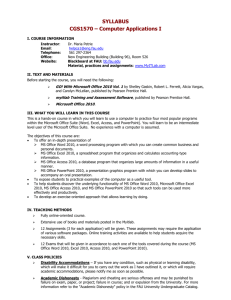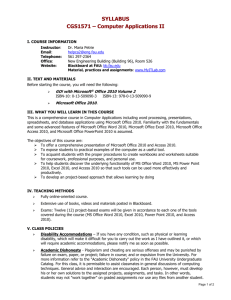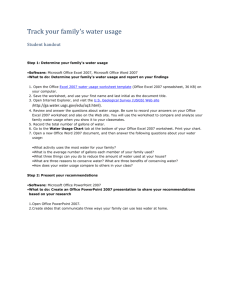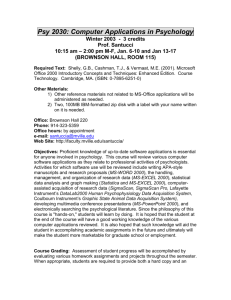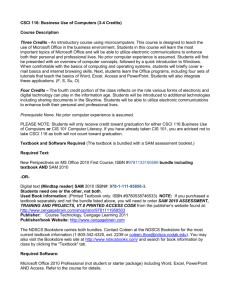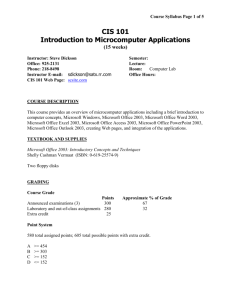Microsoft Office 2007 – Illustrated Second Course
advertisement
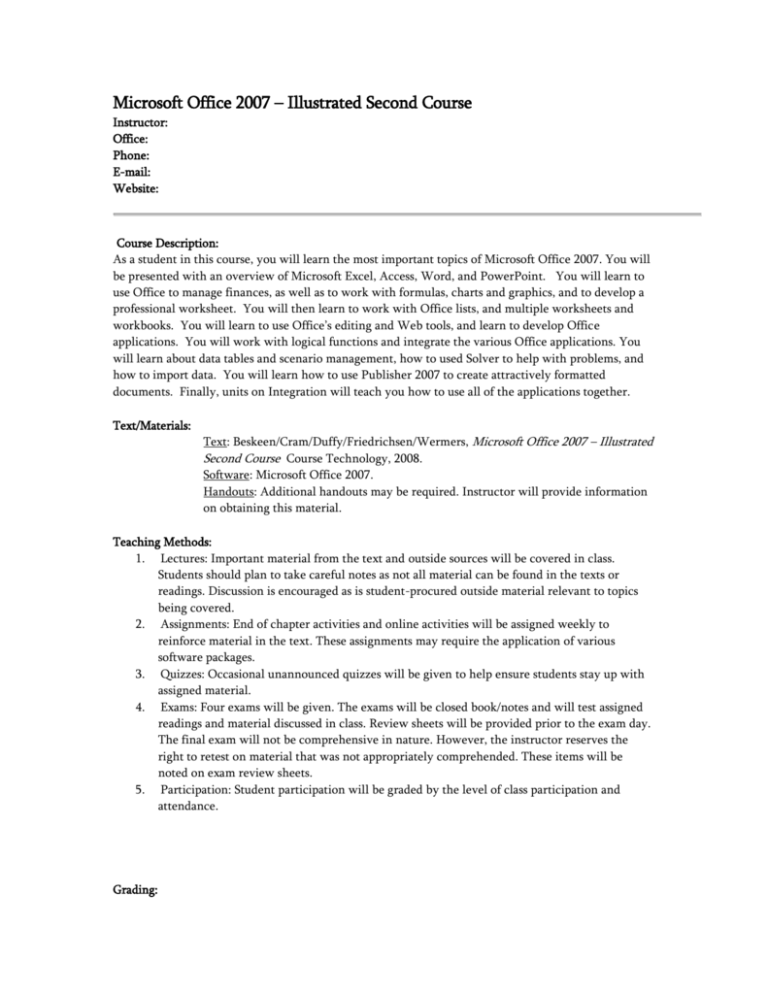
Microsoft Office 2007 – Illustrated Second Course Instructor: Office: Phone: E-mail: Website: Course Description: As a student in this course, you will learn the most important topics of Microsoft Office 2007. You will be presented with an overview of Microsoft Excel, Access, Word, and PowerPoint. You will learn to use Office to manage finances, as well as to work with formulas, charts and graphics, and to develop a professional worksheet. You will then learn to work with Office lists, and multiple worksheets and workbooks. You will learn to use Office’s editing and Web tools, and learn to develop Office applications. You will work with logical functions and integrate the various Office applications. You will learn about data tables and scenario management, how to used Solver to help with problems, and how to import data. You will learn how to use Publisher 2007 to create attractively formatted documents. Finally, units on Integration will teach you how to use all of the applications together. Text/Materials: Text: Beskeen/Cram/Duffy/Friedrichsen/Wermers, Microsoft Office 2007 – Illustrated Second Course Course Technology, 2008. Software: Microsoft Office 2007. Handouts: Additional handouts may be required. Instructor will provide information on obtaining this material. Teaching Methods: 1. Lectures: Important material from the text and outside sources will be covered in class. Students should plan to take careful notes as not all material can be found in the texts or readings. Discussion is encouraged as is student-procured outside material relevant to topics being covered. 2. Assignments: End of chapter activities and online activities will be assigned weekly to reinforce material in the text. These assignments may require the application of various software packages. 3. Quizzes: Occasional unannounced quizzes will be given to help ensure students stay up with assigned material. 4. Exams: Four exams will be given. The exams will be closed book/notes and will test assigned readings and material discussed in class. Review sheets will be provided prior to the exam day. The final exam will not be comprehensive in nature. However, the instructor reserves the right to retest on material that was not appropriately comprehended. These items will be noted on exam review sheets. 5. Participation: Student participation will be graded by the level of class participation and attendance. Grading: Total points will be computed as follows. The total points for quizzes, cases, and assignments may vary. Exam #1: 100 Exam #2: 100 Exam #3: 100 Exam #4: 100 Assignments: 150 Participation: 50 Total: 600 Points Point System: 600 total assigned points A >= 500 B >= 450 C >= 400 D >= 350 Course Policies: Missed Classes: The student is responsible for obtaining material distributed on class days when he/she was absent. This can be done through contacting a classmate who was present or by contacting the instructor during his office hours or other times. Missed or late quizzes can not be made up under any circumstances but with good cause and adequate notice, an early quiz may be given. One quiz (lowest score) will be dropped at the end of the semester. Assignments: All assignments are due at the beginning of class on the date due. Late submission of assignments will be assessed a penalty of 10% per day. No exceptions are made. Academic Dishonesty: Plagiarism and cheating are serious offenses and may be punished by failure on exam, paper or project; failure in course; and or expulsion from the University. For more information refer to the "Academic Dishonesty" policy in the University Undergraduate Catalog. For this class, it is permissible to assist classmates in general discussions of computing techniques. General advice and interaction are encouraged. Each person, however, must develop his or her own solutions to the assigned projects, assignments, and tasks. In other words, students may not "work together" on graded assignments. Need for Assistance: If you have any condition, such as a physical or learning disability, which will make it difficult for you to carry out the work as I have outlined it, or which will require academic accommodations, please notify me as soon as possible. Internet Support: Check the class Web page for additional information about Office 2003, or to post a question about this course. Posting of Grades: Final grades will not be posted. If you wish to have your final grade sent to you, please bring a self-addressed, stamped envelope to the final exam. Incomplete Policy: Students will not be given an incomplete grade in the course without sound reason and documented evidence as described in the Student Handbook. In any case, for a student to receive an incomplete, he or she must be passing and must have completed a significant portion of the course. Course Outline Assignment Descriptions: Concepts Review – Includes screen identification, multiple choice, and matching questions. Skills Review – Provides additional hands-on exercises that mirror the progressive style of the lesson material. Independent Challenges 1, 2 and 3 – Case projects that require critical thinking and application of the unit skills. The Independent Challenges increase in difficulty, with the first being the easiest (with the most step-by-step detailed instructions). Independent Challenges 2 and 3 become increasingly more open-ended Real Life Independent Challenge – Using a real world focus to apply the unit skills, students create documents that will benefit their every day lives Advanced Challenge Exercises – Optional steps that are set within 2 of the 4 Independent Challenges for each unit. They are designed to challenge more advanced students. 2 solution files are provided for easy grading. Visual Workshop – a practical, self-graded capstone project that requires independent problem solving. Week 1 2 3 4 5 6 7 Topic Introduction to Course Word 2007 Unit E: Creating and Formatting Tables Word 2007 Unit F: Illustrating Documents with Graphics Word 2007 Unit G: Working with Themes and Building Blocks Word 2007 Unit H: Merging Word Documents Excel 2007 Unit E: Analyzing Data Using Formulas Excel 2007 Unit F: Managing Workbook Data Excel 2007 Unit G: Using Tables Excel 2007 Unit H: Analyzing Table Data Integration Unit D: Integrating Word and Excel Exam #1 Access 2007 Unit E: Modifying the Database Structure Access 2007 Unit F: Creating Multiple Table Queries Access 2007 Unit G: Enhancing Forms Assignment none Concepts Review Skills Review 2 Independent Challenges Internet Visual Workshop Office Independent Challenge #1 Concepts Review Skills Review 2 Independent Challenges Visual Workshop Concepts Review None Skills Review 2 Independent Challenges Excel Visual Workshop Integration Visual Workshop 8 9 10 11 12 13 14 Access 2007 Unit H: Analyzing Data with Reports Integration Unit E: Integrating Word, Excel, and Access Exam #2 PowerPoint 2007 Unit E: Working with Advanced Tools and Masters PowerPoint 2007 Unit F: Enhancing Charts PowerPoint 2007 Unit G: Inserting Illustrations, Objects, and Media Clips PowerPoint 2007 Unit H: Using Advanced Features Integration Unit F: Integrating Word, Excel, Access, and PowerPoint Exam #3 Publisher 2007 Unit A: Getting Started with Publisher 2007 Publisher 2007 Unit B: Working with Text and Graphics Publisher 2007 Unit C: Creating a Web Publications Review Final Exam Concepts Review Skills Review None 2 Independent Challenges Visual Workshop Concepts Review Skills Review 2 Independent Challenges None Visual Workshop Concepts Review Skills Review None None
